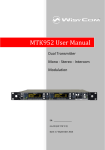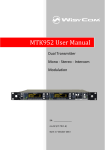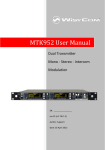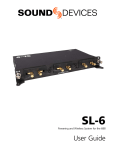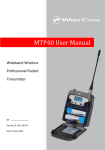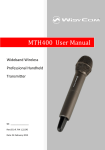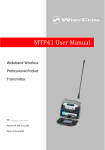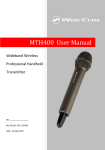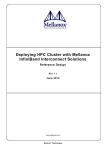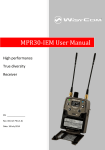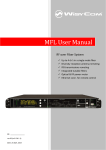Download MTK952 User Manual
Transcript
MTK952UserManual Dual Transmitter Mono ‐ Stereo ‐ Intercom Modulation SN: ________________ rev.05 (ref. FW 2.0) Date: 16 December 2014 MTK952UserManual rev.05 BRIEFDESCRIPTION MTK952 is a versatile dual transmitter capable of working in a huge UHF bandwidth and of generating any kind of narrow‐band modulations, with very high quality and low spurious emissions. Mainfeatures: 330 MHz Bandwidth (470 MHz – 800 MHz) 2400 user‐defined frequencies (40 group by 60 freq.) Stereo, mono, intercom audio modulation Output power up to 2 Watt (/W option) Analogue & digital input (AES3) Redundant power supply 230/110 Vac & 12 VDC DSP audio processing (40bit floating point / 2Gflops) with multi‐companding Direct Digital Synthesis (DDS) of signal for the highest flexibility and quality (> 70 dB stereo separation)s SWR (Stationary Wave Ratio) sensing on antenna outputs Above a schematic with the functional diagram of one transmitter of MTK952. MTK952 use extreme technologies like: Direct Digital Synthesizer (DDS) DDS is a type of frequency synthesizer used for creating arbitrary waveforms from a single, fixed‐frequency reference clock. A DDS has many advantages over its analog counterpart, the phase‐locked loop (PLL), including much better frequency agility, improved phase noise, and precise control of the output phase across frequency switching transitions. The Direct Digital Synthesis (DDS) technology can generate virtually any kind of modulation while keeping an absolute phase accuracy. Double conversion stage Using a double conversion and saw filter at IFs (intermediate frequencies) we can achieve a very low spurious emission and a great bandwidth agility (330 MHz). Intermodulation cancelling power amplifiers PA module (power amplifiers) is designed with an exclusive circuitry that reduce the intermodulation generated by external carriers using a wideband phase cancelling design. Digital audio with Shark™ DSP 40bit floating point & 2 Gflops power from Analog Device A very powerful Analog Design Shark DSP processor manages the audio with very low delay (< 1 ms) and emulates by software all companding and pre‐emphasis effects. MTK952UserManual rev.05 SAFETYINSTRUCTION Read this safety instruction and the manual first Follow all instructions and information. Do not lose this manual. Do not use this apparatus under the rain or near the water. Do not install the apparatus near heaters or in hot environments, do not use outside the operating temperature range. Mount the apparatus as indicated in the instruction, do not block side grids for air ventilation ATTENTION: supply the apparatus with a correct mains voltage and with the ground connection. Check the power cord integrity. The power cord must be protected from damage Do not install the apparatus near heaters or in hot environments, do not use outside the operating temperature range. Do not open the apparatus, only qualified service technician are enabled to operate on it. The apparatus needs servicing when it is not properly working or is damaged by liquids, moisture or other objects are fallen in the apparatus. Use only accessories or replacement parts authorized or specified by the manufacturer. Clean the apparatus only with dry cloths, do not use liquids. The ON/OFF is a double pole circuit breaker, but to ensure the complete disconnection of the apparatus, disconnect the power cord. Report the serial number and the purchasing date in front of the manual. It is needed to have proper replacement parts or accessories from the manufacturer. When replacement parts are needed, use only replacement parts authorized from the manufacturer. Substitution with not authorized parts could result in electric shock, hazards or fire. Keep attention on all the labels with warnings or hazards on the apparatus. WARNING! The apparatus is intended for professional use; anyway the manufacturer alerts the user that the headphone output power of the apparatus could exceed the level of 85 dB(A) of sound pressure level and this could be dangerous for the hearings. Do not use the headphone with high power level or for long time. Reduce the power or suspend the hearing in case of any kind of hearing problem. MTK952UserManual rev.05 QUICKSTARTINSTRUCTION 1. 2. 3. 4. 5. 6. Connect to the power outlet using the supplied power cable (see rear panel: connector 1) Attach the antennas to the antenna out BNC connections (N connectors for MTK952N) (see rear panel: connectors 8 and 13) Connect the audio sources to the relative audio input connectors (see rear rear panel: connectors 7 for digital audio sources, connectors 9÷12 for analog audio sources) NOTE: the cascade configuration allows to use the same analog audio input for more transmitter Power on the MTK952 Switch off the RF output: rd a. While the MTK952 is powering on and the progress bar appears, push the 3 button at the bottom (see indication “OFF” on the display) b. At the end of MTK952 power on, push the lower button on the right of the displays Enter in the MAIN>Audio source menu and a. configure the input parameter between digital and analog (according to the audio source connected at point 3) b. configure the AF level meter parameter as modulation c. if digital audio source: leave audio gain left and right parameters to 0dB and adjust the audio level with the mixer if need change the audio gain left and right parameters d. if analog audio source: leave audio gain left and right parameters to 0dB and adjust Max audio level parameter. NOTE: this parameters is unique for both the channels (right and left) if need change the audio gain left and right parameters NOTE: adjust the audio level (thru the mixer and/or Max audio level and/or the audio gain left and right parameters) so that, for the maximum input signal level, the AF level bars show the MAXIMUM NUMBERS OF GREEN LED INDICATORS AND NO YELLOW/RED CLIP LED INDICATORS NO YES the MOD. (modulation) bar shows the MAXIMUM NUMBERS OF GREEN LED INDICATORS AND NO YELLOW/RED PEAK LED INDICATOR NO YES 7. 8. Enter in the MAIN>Ch‐Gr menu and set the group/channel/ frequency Enter in the MAIN>Mode menu and set the appropriate Mode (see Compatibility table for more detail) 9. Enter in the MAIN>TX Power menu and set the TX power (10÷200mW) 10. Exit from the menu and switch on the RF power output pushing the lower button on the right of the display MTK952UserManual rev.05 FRONTPANELCONTROLANDFUNCTIONS MTK952 allows an easy and quick configuration using buttons, push knobs and displays. A B C D E The front panel is functionally divided in the following section: A–SCAN,SYNCandINFRARED Automatic sync with “MPR30” receiver through infrared interface. The SCAN function allows to display the results of a scan previously done from a MPR30 and set a frequency on the receivers. BandC‐TRANSMITTER1andTRANSMITTER2 Transmitter 1 and 2 configuration and monitor of radio/audio levels. ❶ Audio and Modulation indicators two LED bars for the AF levels (L=left & R=right levels): they can show AF input levels or modulation levels (after the pre‐emphasis and compander phases, before the modulation phase) according to the AF level meter parameter on Audio source menu FM modulation of the transmitter channel (modulation in dB referred to the nominal deviation) ❷ LCD display.(64 x 254 yellow‐lighted display) ❸ 3 push buttons (membrane). The function of each button (upper, middle and lower) will be readable from the context menu on the display. ❹ Push rotary knob. Rotate and push to select. ❺ Warning (YELLOW) and Alarm (RED) light indicator D‐MONITOR Monitor 1 and 2: it actives monitor audio on headphone jack output (6.3mm ‐ ¼”) for transmitter 1 and 2, respectively (a green LED is lighted when audio is enable). Audio level can be adjusted with the rotary knob. The red led (CLIP) indicates a clipping in the audio monitor output. E‐POWER&LOCK LOCK: it locks the editing of both the displays. POWER: ON/OFF square powering button turns on/off the transmitter. When in OFF position both phases are disconnected from power. MTK952UserManual rev.05 REARPANEL ❶ ❷❸❹ ❺❻ ❼ ❽ ❾ ❿ ⓫ ⓬ ⓭ MTK952N ⓮ ⓯ ❶ ❷❸ ❹ ❺❻ ❼ ❽ ❾ ❿ ⓫ ⓬ ⓭ MTK952 ❶ AC Power Plug AC mains power input, IEC Connector 90‐264 Vac ❷ Product label with Serial Number, Options and Bandwidth ❸ Ground point To connect the rack to ground ❹ DC Power Plug (optional) DC power input, 10‐16Vdc, Max 7A ❺ label with IP address of Ethernet interface configured on the MTK952 (it can be modified using the Manager application) ❻ Ethernet socket (RJ45) for connection to a network or computer ❼ AES/EBU (XLR 3 pin connector) for digital audio input TX1 and TX2 ❽ Antenna output TX2 (RF output) BNC socket (N socket for MTK952N) ❾ Audio input left TX2 (balanced AF input) ¼” (6,3mm) jack/XLR‐3 combo socket and ¼” jack ❿ Audio input right TX2 (balanced AF input) ¼” (6,3mm) jack/XLR‐3 combo socket and ¼” jack ⓫ Audio input left TX1 (balanced AF input) ¼” (6,3mm) jack/XLR‐3 combo socket and ¼” jack ⓬ Audio input right TX1 (balanced AF input) ¼” (6,3mm) jack/XLR‐3 combo socket and ¼” jack ⓭ Antenna output TX1 (RF output) BNC socket (N socket for MTK952N) ⓮ M‐S input/output connector TX2 (optional) for Master‐Slave option, BNC socket ⓯M‐S input/output connector TX1 (optional) for Master‐Slave option, BNC socket MTK952UserManual rev.05 LCDDISPLAY:TRANSMITTERMENU MTK952infoscreen Switch on the MTK952 and by pushing one of rotatory knobs (at the right of the display) all the basic information are displayed: Display of TRANSMITTER 2 Display of TRANSMITTER 1 On the display of TX2, it is possible to check the max ❶ product and bandwidth ❷ serial number ❸ class and hardware version ❹ Firmware version: it includes application firmware version and DSP firmware version level of power transmitted of the MK952, the installed options and the companders. Option: ‐ W05 / 0W2 /2W0 are the commercial codes to identificate the max power transmitted (50/2000/2000mW) ‐ DC indicate that the DC option (for DC power supply) is installed ‐ MSB indicate that the Master‐Slave board is installed (MS option) Statusscreen After switch on, the transmitters display the Status screen The main view has the following info: ❶ transmitter name ❷ current channel number and current tuning frequency ❸ current group number and group name ❹ current mode ❺ TV channel used for the current frequency ❻ current TX power setting ❼ current SWR (Stationary Wave Ratio) ❽ power supply type ( for AC power for DC power) ❾ menu Thru the main menu on the LCD display and the LED bars for the AF level and modulation the user has the complete monitoring in real time of the wireless channel in use. MTK952UserManual rev.05 MENUTREE MAIN CH: 00 ÷ 59 GR: 00 ÷ 39 Ch‐Gr Frequency: 470÷800 MHz Group name ENR‐Wisy Stereo / EVO Stereo / ENC‐Wisy Stereo / SR Stereo / ENR‐ Wisy / ENC‐Wisy / IFB‐Wisy/ EVO / SEN / SEN ‐d0 / COM‐Wisy 25K / Mode COM‐Wisy 20K / COM‐Wisy 12K5 / USER 1..7 / *1 TX on air at Yes / No startup TX Power 10/20/ 30 /50 / 75 /100/ 150 /200 /250/400/500/750/1000/1200/1500 /2000 mW EXT ATT compens. enable / disable Input Analog / digital Audio source Max audio level ‐6 ÷ 18 dBµ Audio gain left ‐20 ÷ 24 dBµ Audio gain right ‐20 ÷ 24 dBµ AF level meter input / modulation Mono config *2 mono/mono‐R / mono‐L Auto switch DIG‐>AN enabled / disabled G: ‐12 ÷ 12 dB Bass Fr: 40 / 80 / 160 Hz G: ‐12 ÷ 12 dB Fr: 1.5 / 2.2 / 2.8 KHz Mid Q: 0.7 / 1.0 / 2.0 Equalizer G: ‐12 ÷ 12 dB Treble Fr: 5.0 / 7.0 / 10.0 KHz SAVE/NEXT/ EXIT Name DISPLAY brightness 0 ÷ 15 DISPLAY timeout 5 ÷ 120 IP Serial Option Range Options Power profile RF amplifier RF generator Temperatures Micro Power supply Info… FW ver Boot ver TX FW master/slave App FW ver configuration DSP FW ver Neg Audio (‐12v5) Only with option 2W0 Pos Audio (+12v5) RF conv. (+5v) RF amplif. (+3v3) Only for MTK952N with M‐S option Supply diagnostic MicroP. (+5v) MicroP. (+8v)*3 *1 Depending on the customization Main RAW (+12v) Alarms * 2 Only with a Mode “mono” PLL tune (+22v) *3 +3v3 for MTK952 “old version” MTK952UserManual rev.05 Name Select for edit Mono/stereo MODE Compander HP filter Flat / 20 /40 / 60 / 80 / 120 / 170 / 250 / 300 HZ LP filter 3 / 4 / 12 / 15 / 20 KHz Pre‐emphasis Bypass / 10‐750 µs FM peak deviation 2 ÷ 100 KHz TSQ frequency 30 ÷ 260 HZ 28 ÷ 34 KHz TSQ deviation OFF / 100 Hz ÷ 5 KHz To access the configuration menu of the transmitter is necessary to press the rotary knob (at the right of the display①). To activate one of the items in the menu, press the corresponding button to the right of the display (see picture hereafter②). ② ① MTK952UserManual rev.05 MAINMENU The first item on the menu tree is “MAIN”. Ch‐Gr The CHANNEL‐GROUP item enables the user to edit channel, channel group and frequency of the selected item. Change, rotating the knob, the channel or the group of channels and confirm or exit with the buttons. To edit the frequency of selected channel, press the middle button and change it with the knob. Press the knob to move between MHz and KHz. Confirm or exit with the buttons. As shown in the above picture, the display area has 3 rows with: 1) 2) 3) Channel number (0 to 60) and Channel frequency (in 5kHz step) Number (1 to 40) and Group name (8 char.) Group description (30 char.) The MTK952 has 40 groups of 60 channels each. Normally this is too much for wireless microphones applications. Connecting with computer with WISYCOM Rack MANAGER software, it is possible to hide single channels or even complete groups of channels: once hidden those items are not shown anymore on the channels or groups selection. To show channels or groups hidden use again the WISYCOM Rack MANAGER software. Using this software it is also possible to lock channels or groups. When a channel is locked, it is not possible to change the frequency from the front panel of the transmitter. Locking a group means that all channels are locked. When a channel or a group are locked, at the left of the group name in the Chan‐Group menu will appear a lock icon . When the lock picture is shown, the central button is not displayed, thus changing frequency is not possible. Groupname The second item on the Main menu is GROUP NAME; with this function is possible to assign or change a name to a group of channel. This short name (8 character) is displayed at the right of the group number in the main display view. First chose the group and then press the knob. You will be able to edit any character of the group name rotating the knob. Push the knob to edit the next character. Confirm or exit with the buttons. NOTE: when the Group name is SYNC (see synchronization) it is not possible to change it. Mode The MODE menu allows to assign a Mode setting at the transmitter. Rotating the knob it is possible to change current mode among the modes available (for more detail see MODE menu). MTK952UserManual rev.05 TXonairatstartup This menu allows to decide if turn ON or turn OFF the RF power of the transmitter while the MTK952 is powering on. If set to No: while the MTK952 is powering on, the RF output remains mute. The Status Screen on the display shows “TX OFF “ and the set Group, Channel and frequency. NOTE: When the RF power of the transmitter is OFF, all the led and the bars remain turned off. Pushing the rotatory knob (at the right of the display) it is possible to activate the led and bars (keeping the RF power OFF) and enter on the menu. rd In order to activate the RF output press the 3 button at the bottom (see indication “ON” on the display). If set to Yes: during the MTK952 power on, the progress bar appears for 10 seconds. During this interval (10 sec.) it is possible to switch off the RF output. If no button is pushed, at the end of the timer the RF output is enabled automatically. TXpower This menu allows to set the power of the transmitter. Rotating the knob it is possible to change current TX power setting among 10/20/50/100/200 mW (2W only for MTK952 with 2W option). Push the SAVE button to confirm. In the same screen is showed the reflected power and the SWR (Stationary Wave Ratio) sensing on antenna outputs. The set TX power and the measured SWR are always showed at the bottom of the display. EXTATTcompens. For future uses. Audiosource This menu allows to set several parameters of audio input Parameters Range setting Function Input Max audio level (only for analog input) Audio gain left digital/analog ‐6/0/6/12/18 dBu ‐20÷24dB Audio gain right ‐20÷24dB AF level meter input/modulation Mono config (only for mono Mode) Auto switch DIG‐>AN Mono/mono‐R/ mono‐L enabled / disabled To set the audio input To change (increase or decrease) the analogue audio input for both R(right) and L(left) channels input To change (increase or decrease) the input level of the left channel on DSP To change (increase or decrease) the input level of the right channel on DSP To set which AF level is shown in the two LED bars for the AF levels (L=left & R=right levels): they can show AF input levels or modulation levels (after the pre‐emphasys and compander phases) To set the type of mono input If enabled and the digital signal is lost (parameter Input set to digital), the transmitter takes the signal from the analog input. MTK952UserManual rev.05 Equalizer This menu allows to of adjusting the gain between frequency components (bass, mid and treble) within the audio signal. There are 4 windows in cascade: bass windows: allows to change gain and frequency of low frequencies mid windows: allows to change gain and frequency of middle frequencies treble windows: allows to change gain and frequency of high frequencies eq windows: allows to save the equalization parameter or exit without save Each window shows the following information: ❶ windows name ❷parameter to set (gain or frequency) ❸ graphic equalizer: frequency on horizontal axis, gain on the vertical axis ❼ ❻ HP filter set in the mode menu LP filter set in the mode menu ❺ ❹ set frequency set gain For each window it is showed the graphic equalizer which help to see the set parameters. Push the rotatory knob to change the parameter between gain and frequency (the respective letter G or Fr is highlighted during the setting phase) and rotate it to change the value of the parameter. The set value is showed on the bottom of the windows (see points ❹ and ❺ on the above image). Push the lower membrane button to go on the next windows. The following table recaps the settable values on the 3 windows: Fr (frequency) G (gain) Q (Q factor) bass 40/80/160 Hz ‐ ‐12÷12dB (1dB step) mid 1.5/2.2/2.8kHz 0.7/1.0/2.0 treble 5/7/10kHz ‐ NOTE: High Q factor means narrow bandwidth. Low Q factor means wide bandwidth. MTK952UserManual rev.05 Options This menu allows to change some parameters of the transmitter or display some information Parameters Name DISPLAY brightness DISPLAY timeout Serial FW Supply diagnostic Info Alarms Function To change the name of the transmitter shown in the Status screen. 12 alphanumeric characters (A‐Za‐z0‐9, case‐sensitive) To set the brightness of the display To set the display timeout for: decrease the brightness of the display and return to Status screen to show the IP address 0÷15 step 1 5÷60 step 5sec. 60÷120 step 10 sec. ex. 192.168.10.1 ex. R1825694 IP address Option Range Temperatures Range setting ex. TRANSMITTER1 RF amplifier RF generator Micro ex. 0W2 ex. 470‐800 ex. 30°C ex. 31°C ex. 33°C Power supply ex. 31°C FW ver ex. 1.1 Boot ver App FW ver DSP FW ver Neg Audio (‐12v5) Pos Audio (+12v5) RF conv. (+5v) RF amplif. (+8v) MicroP. (+5v) ex. 0.2.d ex. 0.36.d ex. 0.61.d ex. ‐12.42V ex. 12.36V ex. 5.33V ex. 7.82V ex. 5.14V Micro.P (+3v3) ex. 3.41V Main RAW (+12v) PLL tune (+22v) ex. 12.62V ex. 23.29V ex. 0 to show the serial number of the product (the same indicated in the product label) To show the option to show the frequency range (MHz) to show the temperature took near the RF amplifier (°C) to show the temperature took near the RF generator (°C) to show the temperature took near the RF microprocessor (°C) to show the temperature took near the power supply (°C) to show the firmware version (it sums up Boot+App+DSP versions) to show the bootloader version to show the application firmware version to show the DSP firmware version To show the power supply of the input audio stages To show the power supply of the output audio stages To show the power supply of the RF converters To show the power supply of the RF amplifiers To show the power supply of the microprocessor and the digital section To show the power supply of the microprocessor and the digital section To show the main power supply To show the power supply of the PLL To show the number “n” of active alarms: n=0 0 active alarms n>0 n active alarms When “n”>0, it is possible to enter in the alarm submenu which allows to show the alarms list: a brief description and an alarm code for each alarm. For the complete list of alarms, see Alarm List section Note: the complete software and hardware status is displayed on the MTK952 info screen MTK952UserManual rev.05 TXconfiguration(onlyforMTK952NwithoptionMS) This parameter permits to use the transmitter in Master or Slave configuration. When the MTK952N is in Master configuration, the signal is transmitted as a normal MTK952N (without MS option) but at the same time, the signal is sent also in the M‐S I/O BNC connector at 0dBm (without amplification). When the MTK952N is in Slave configuration, everything that is before the power stage is excluded and the device take as input the signal that enter in the M‐S I/O BNC connector, amplifies the signal (at the power set on the MTK952N‐Slave) and transmits it. MTK952N is able to detect a signal in the range ‐6dBm ÷ +6dBm (than the 0dBm sent from the MTK952 Master). Exampleofconfigurations:iso‐frequencyareas MTK952N Master conf. Audio input Area 1 Coaxial cables up to several tens of meters (depending on the cable) MTK952N Master conf. MFL‐TT‐‐ MTK952N Slave conf. Area 2 MTK952N Slave conf. Audio input Area 3 Fiber optic cable up to several tens of kilometers (depending on the fiber) MFL‐RR‐‐ Area 4 MTK952UserManual rev.05 MODEmenu The second item on the menu tree is “MODE”. It allows to manage several modes. Each mode is a setup saved in an external memory that allows to customized the transmission changing some parameters of the DSP. There are 2 types of modes: PRESET mode: it allows to change only some parameters (the other are fixed). See compatibility table at the end of the manual for more detail USER mode: it allows to change all the parameters. Currently 8 USER modes are available The menu Select for edit allows to select the MODE to edit. Push the knob to select the mode and push the button LOAD to load the previously saved parameters. It is possible to change the parameter value only where the EDIT indication appears. ① ② During this phases, the name of the MODE to edit appears on the left top of the display ①. If the MODE to edit is the current mode loaded on DSP (on the Main>Mode menu), “dsp” abbreviation is shown ②. Shown below the complete parameters list Parameter Name Range setting Description name of mode Changeable PRESET MODE USER MODE no yes Mono/stereo mono/stereo type of transmission no yes Compander compander type no yes HP filter Flat/20/40/60/80/ 120/170/250/300 Hz High Pass filter yes yes LP filter 3/4/12/15/20 Kz Low Pass filter yes yes Pre‐emphasis Bypass/10‐750 µs Pre‐emphasis yes FM peak deviation 2÷100 KHz Max peak deviation yes TSQ frequency 30÷260Hz 28÷34KHz TSQ deviation OFF/100Hz÷5kHz (audio+tone squelch) and Frequency of Tone Squelch signal Deviation of Tone Squelch signal related to the mode yes yes MTK952UserManual rev.05 Synchronization The SYNC function is useful to tune a transmitter on the same frequency of the receiver via the IR interface. Enable the IRDA on the receiver and place the IR windows of the receiver in front of the IR interface of the transmitter as indicate in the below image. TX‐>RX RX‐>TX Press the SYNC button on the transmitter: the following message is showed on both the displays Using the membrane buttons of the desired transmitter (TX1 or TX2) select: TX‐>RX to set the receiver at the same frequency of the transmitter: the transmitter will send to the receiver some parameters (frequency, channel, group and transmitter’s name) and after synchronization, the receiver shows the name of the transmitter RX‐>TX to set the transmitter at the same frequency of the receiver: the receiver will send to the transmitter some parameters (frequency, channel, group and receiver’s name) and after synchronization, the transmitter shows the name of the receiver (ex. SINGER_1) If the operation is not possible, (i.e. the frequency range of the transmitter is not compatible with the frequency of the receiver or vice versa), the display shows an error message. If the synchronization is successful, the display of the devices shows number of channel and group or SYNC channel according to the frequency plan memorized on the Wisycom product: MTK952UserManual rev.05 Message displayed after the synchronization Status screen Case B Case A CASE A: if frequency, channel and group are the same in the two devices, channel and group are also displayed (ex: CH00: 566.000, GR39: Unlock) CASE B: If frequency, channel & group of the transmitter are different from those of the receiver, the transmitter shows only the frequency after the word SYNC. (ex: SYNC: 620.000) Ex: RX‐>TX MTK952UserManual rev.05 Scan The SCAN function allows to display a results of a scan previously done from a MPR30‐IEM or MPR30‐ENG. Do a scan with an MPR30‐IEM Enable the IRDA on the receiver or select the function Deploy on the SCAN menu (only for MPR30‐ENG with FW>1.9 and MPR30‐IEM with FW>1.6) and place the IR windows of the receiver in front of the IR interface of the transmitter Press the SCAN button on the transmitter: the following message is showed on both the displays. : Using the membrane buttons of the desired transmitter (TX1 or TX2) select GET Wait some seconds (the receiver sends all the data of the scan to the transmitter) The display of transmitter1 show the scan result in graphic way, while the display of transmitter2 gives more detailed information of the result (according to the position of the cursor in display1) Ex. FREQUENCY SCAN Display of Transmitter1 Display of Transmitter2 Ex: GROUP SCAN Display of Transmitter1 Display of Transmitter2 MTK952UserManual rev.05 Use the membrane buttons on display2 to set the frequency to TX1 – TX2 NOTE: The results of the scan are saved on the volatile memory of the transmitter: ‐ After the switch off of the transmitter the data are lost. ‐ It is possible to re‐load the data of a previous scan. Pushing the SCAN button and selecting VIEW MTK952UserManual rev.05 AlarmList When an alarm occurs, the MTK952 can do one or more of the following acts: A. Show a message on the display B. Turn on the yellow or red alarm led C. Insert the alarm on the alarm list in the MAIN>Options>Info>Alarms menu The alarm can be related to a specific transmitter (TX1 or TX2) or general. Shown below the complete alarms list: Alarms Code Type Message on display (A) Led (B) TX Power Mismatch ‐ TX TX Power reduced 0x05 TX Timeout 5 sec on PLL Errore bus I2C 0x84 TX general Timeout 5 sec on PLL OL969 High internal temperature 0x84 general 0x04 general Fan #1 doesn't work 0x02 general Fan #2 doesn't work 0x03 general Recovered configuration and calibration data from copy1 on the memory Recovered configuration and calibration data from copy2 on the memory Load default configuration and calibration data 0x80 Alarm list (C) yellow no yellow Tx power reduced red red Rf PLL lock lost Error on I2C bus OL PLL lock lost general ATTENTION: antenna mismatch! High SWR on Tx out ATTENTION: antenna mismatch! High SWR on Tx out. Rf pwr reduced ATTENTION: RF PLL lock lost EEPROM access error (only on TX1) ATTENTION: OL PLL lock lost (only on TX1) ATTENTION: internal temperature high (only on TX1) ATTENTION: fan #1 does't work properly (only on TX1) ATTENTION: fan #2 does't work properly (only on TX1) no 0x81 general 0x8D general red yellow High internal temperature yellow Fan #1 doesn't work yellow Fan #2 doesn't work no Mem. copy1 recovered no no Mem. copy2 recovered no no Mem. init. Service req. MTK952UserManual rev.05 Troubleshooting Alarms TX Power Mismatch Alarm description The SWR on Tx out is too high reduced TX Power The SWR on Tx out is too high, the RF power is reduced Timeout 5 sec on PLL bus I2C Error Timeout 5 sec on PLL OL 969 High internal temperature Error during frequency tuning Error on I2C bus Error during frequency tuning Fan #1 doesn't work The fan on the left (#1) doesn’t turn The fan on the right (#2) doesn’t turn During the MTK952 initialization phase, the CRC‐16 check of data (copy1) detects error. Fan #2 doesn't work Recovered configuration and calibration data from copy1 on the memory Recovered configuration and calibration data from copy2 on the memory Load default configuration and calibration data One of the 4 temperature sensors measures a temperature > 60°C Troubleshooting ‐ check if the antenna is correctly connected ‐ check if the antenna cable is correctly connected ‐ check if the antenna frequency is according to the one set on the transmitter ‐ check if the antenna is correctly connected ‐ check if the antenna cable is correctly connected ‐ check if the antenna frequency is according to the one set on the transmitter ‐ send to repair at Wisycom Repair Centre ‐ send to repair at Wisycom Repair Centre ‐ send to repair at Wisycom Repair Centre ‐ check if the two fans work properly (check alarms code 0x02 or 0x03 on the alarm list) ‐ switch off the MTK952 for cooling and check the location temperature ‐ clean the ventilation grids ‐ switch off and switch on the MTK952 ‐ switch off and switch on the MTK952 ‐ none (the MTK952 automatically replaces the corrupt copy1 with copy2) During the MTK952 initialization phase, the CRC‐16 check of data (copy2) detects error. ‐ none (the MTK952 automatically replaces the corrupt copy2 with copy1) During the MTK952 initialization phase, the CRC‐16 check of data (copy1 and copy2) detects error. ‐ check in the MAIN>Options>info menu the Serial take on the ‘UNCAL’ vale. In this case send the MTK952 to the Wisycom Repair Centre for recalibration. If a problem not listed in the above table occurs or if the problem cannot solved with the proposed troubleshooting, please contact support service at [email protected] or [email protected]. MTK952UserManual rev.05 RACKTXMANAGERMTK952 HowtoinstallRackTxManagerMTK952 Run the executable file (i.e. Rack Tx Manager (MTK952) SERVICE vx.x.x.x Setup.msi) and follow the installation instructions. HowtoupdateRackTxManagerMTK952 Uninstall the Rack Tx Manager MTK952 program active in your computer and afterwards install the newest version of Rack Tx Manager MTK952. HowtoconnectMTK952toRackTxManagerMTK952 1. Connect to the PC to the MTK952using the supplied Ethernet cable 2. Run Rack Tx Manager MTK952 3. Power on the transmitter 4. Push Disconnected button. On the Device connection windows select Ethernet port and fill in the MTK952 IP address. Remember that the label on the rear panel shows the IP address configured in the factory. Then click OK. 5. If the connection is ended well, the Connected icon is showed on the top of the panel and “Connected on Ethernet” is displayed on the information panel MTK952UserManual rev.05 Howtoload/savechannelsmemory Select Channel memory panel Write: Push the button Write from WDF file… and select the wdf file to load a wdf file on the MTK952. Read and save: Push the button Read and save to WDF file… , insert the .wdf file name and the path where to save the wdf file. During the process of writing/reading & saving, a green bar below the panel shows the progress of the process and on the information panel it is possible to verify what the application is doing. To Modify the wdf file, it is possible to use the spreadsheet FREQUENCY 2010 v15 beta.xls presents at the following link: ‐ open the file and enable changes and macro ‐ load the wdf file clicking on READ WDF button ‐ execute the desiderate changes ‐ save the wdf file clicking on SAVE WDF button The WDF thus modified can be used to write on the MTK952’s channels memory. MTK952UserManual rev.05 TECHNICALSPECIFICATION Switchable channels : 2400 allocated by 40 groups of 60 channels quickly selectable with dedicated buttons Frequency bandwidth : 470‐800 MHz Switching bandwidth : 330 MHz tuneable in 5 kHz steps Temperature range : ‐10 ÷ +55 °C RF output power : Selectable: 10,20,50,100,200 mW for MTK952‐0W2 Max RF output power : MTK952‐W05: 50mW MTK952‐0W2: 200mW MTK952‐2W0: 2Watt [NOTE] RF power can be limited on frequency base accordingly to specific country restrictions (software based) “A” / “B” antenna output : BNC type female connectors (for MTK952) N type female connectors (for MTK952N) M‐S I/O : 2x BNC type female connectors (only for MTK952N with MS option) RF impedance : 50 Ω Spurious emissions : < 2 nW (in the transmitter bandwidth) Modulation : FM, MPX Stereo or mono, selectable with dedicated menu Peak deviation : ±56 kHz for mono, ±48 kHz for stereo (preset mode) NOTE: custom setting can set peak deviation from 2kHz to 100kHz MPX Pilot tone : 19kHz Tone squelch : 32.789Hz (for Wisycom wireless microphone, i.e. ENR/ENC) 131,8 (for Wisycom intercom, i.e. NR) NOTE: custom setting can change the Tone squelch (30‐260Hz and 18‐38KHz) Frequency response : 20÷20kHz (mono) 30÷15kHz (stereo) NOTE: custom setting can change audio bandwidth (3/4/12/15/20kHz) Analogue audio input Connector type Max. input level : : Pin Assignments : XLR‐3 / 1/4“ (6,3mm) jack combo socket, electronically balanced +18dBu XLR: 1=ground 2=hot 3 =cold 6.35mm (1/4”) TRS: Tip=hot Ring=cold Sleeve=ground Digital audio input Connection : AES3 on XLR‐3M (32kHz ÷108 kHz) Monitor output Connector type Monitor output level Monitor out impedance : : 6.35mm (1/4”) jack socket, balanced 120+120mW@24Ω , 80+80mW@150Ω : 25 ohm for auricle Compander : ENR (Wisycom Extended‐NR), with independent Attack‐ and Recovery‐time, noise optimized ENC (Wisycom Extended‐NC), with independent Attack‐ and Recovery‐time, voice optimized & with reduced pre‐emphasys NONE‐d50, no compander, pre‐emphasis 50 µs NR, to work with Wisycom Intercom system Other compander on request Display : 64 x 256 OLED (yellow) Configuration/monitor interfaces : 10/100 Base TX Ethernet port on RJ45 connector Power supply : 90 ‐ 264 V AC, 50/60 Hz 10 – 16 VDC, Max 7A (option DCI952) Dimensions : 19”/1U 483 x 407 x 43,8 mm (WxDxH) with brackets Stereo Stereo Mono Mono Mono Mono Mono Mono ENR‐Wisy Stereo ENC‐Wisy Stereo ENR‐Wisy ENC‐Wisy IFB‐Wisy COM‐Wisy 25K COM‐Wisy 20K COM‐Wisy 12k5 *adjustable parameter Mono/Stereo Name Max peak deviation 48 kHz 48 kHz 56 kHz 56 kHz 40 kHz 4,5 kHz* 4 kHz* 2,3 kHz* Compander type ENR ENC ENR ENC ENR NR NR NR MODE SETTING YES YES YES YES YES YES NO NO Send Tone Squelch CPR30 CSR50 RPU300 (Rx) MRP30‐IFB MCR42 MPR30‐ENG MRK960 MRK950 MSR916 (ENR) Unavailable MPR30‐IEM WISYCOM RECEIVER MTK952UserManual rev.05 Modesetting&Wisycomreceivercompatibility NOTE: receiver and transmitter have to be configured with the same compander type MTK952UserManual rev.05 MTK952UserManual rev.05 ENVIRONMENTAL INFORMATION Applicable in the European Union and other European countries with separate collection systems Disposal of Old Electrical & Electronic Equipment (2002/96/EC) This symbol indicates that this products shall not be treated as household waste. Instead it shall be handed over to the appropriate collection point for the recycling of electrical and electronic equipment. The recycling of material will help to conserve natural resources. ITALY ONLY Obblighi di informazione agli utilizzatori ai sensi dell’art. 13 del Decreto Legislativo 25 luglio 2005, n. 151 “Attuazione delle Direttive 2002/95/CE, 2002/96/CE e 2003/108/CE, relative alla riduzione dell’uso di sostanze pericolose nelle apparecchiature elettriche ed elettroniche, nonché allo smaltimento dei rifiuti” Smaltimento di apparecchiature elettriche ed elettroniche di tipo professionale Il simbolo del cassonetto barrato riportato sull’apparecchiatura o sulla sua confezione indica che il prodotto alla fine della propria vita utile deve essere raccolto separatamente dagli altri rifiuti. La raccolta differenziata della presente apparecchiatura giunta a fine vita è organizzata e gestita dal produttore. L’utente che vorrà disfarsi della presente apparecchiatura dovrà quindi contattare il produttore e seguire il sistema che questo ha adottato per consentire la raccolta separata dell’apparecchiatura giunta a fine vita. L’adeguata raccolta differenziata per l’avvio successivo dell’apparecchiatura dismessa al riciclaggio, al trattamento e allo smaltimento ambientalmente compatibile contribuisce ad evitare possibili effetti negativi sull’ambiente e sulla salute e favorisce il reimpiego e/o riciclo dei materiali di cui è composta l’apparecchiatura. Lo smaltimento abusivo del prodotto da parte del detentore comporta l’applicazione delle sanzioni am‐ ministrative previste dalla normativa vigente. Iscrizione al Registro A.E.E. n. IT09100000006319 MTK952UserManual rev.05 Wireless System Communications Via Spin 156 I‐36060 Romano d’Ezzelino Italy Tel. +39 ‐0424 ‐382605 Fax +39 ‐ 0424 ‐ 382733 www.wisycom.com e‐mail: [email protected]




























